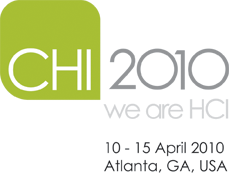CN02: Do try this at home! A consumer’s guide CHI research for practitioners
Quick Facts
Time: Sunday, 11 April 2010, 19:00 to 22:00Units: 2
Organizers: Kath Straub
Benefits
CHI can be intimidating and frustrating for practitioners. It is filled with academics theorizing about things that seem like they should be relevant to every day practice. But, as is said, the difference between theory and practice is ofen greater in practice than it is in theory. And practitioners, who ofen hail from non-scientific backgrounds, don’t have the scientific background or rhetorical/logical skills to effectively read and assess the claims made in scientific presentations and papers. (This is especially true for brief, dense papers like those presented at CHI.) This course is specifically designed for those practitioners. Within the course we will review key parameters of critical thinking and experimental design so that practitioners can become equally effective, confidently vocal and discriminating consumers of current CHI research.Audience
This course is intended for practitioners and students. However, any CHI participant who seeks to build or refresh their basic experimental background and scientific reasoning skills can benefit. Experienced scientists and researchers should not take this course.Origins
This course is the amalgam of courses that have been presented in other venues: (1) “Bringing Research to Life: Studies UX Practioners should know” has been updated and presented annually at UPA and within the HFI CUA track. In both industry training examples, it receives very high (5/5 for “Would you recommend to your peers?”) evaluaions from attendees. In addition, this course draws content from the instructor’s University Introductory Psychology / Introductory Cognitive Ergonomics curriculum. These courses were also enthusiastically received, largely due to the highly interacive, pracice the concepts oriented format which clearly modeled immediate applicaions for the knowledge to the world.Features
Participants develop and practice evaluative and critical thinking skill in the context of evaluating experimental design. By the end of the session, participants should have developed a greater (self-)awareness of:- the difference between a hypothesis and a theory (and how one may get to be the other)
- the “seams” and limits of experimental design and their impact on validity, reliability and generalizability (e.g., operationalizing, falsifiability)
- the use and real meaning of key statistical constructs (e.g. p-value)
- how to evaluate claims (and common mistakes researchers make in reasoning)
- how biases and predispositions influence our evaluation of research in practice and in daily life
- the use of language and framing to distract from the core argument
- the complexity of generalizing from lab to life (e.g., validity, reliability)



